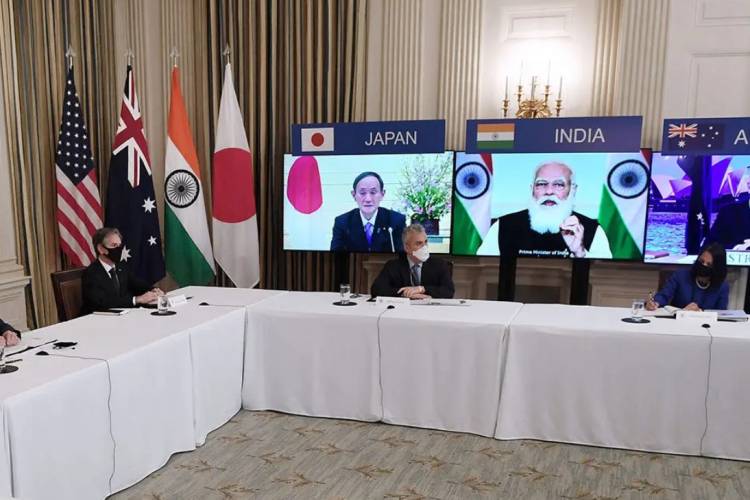
Formed as a response to the shifting global power dynamics, QUAD is shaping the future of the Indo-Pacific. Originally conceived in 2007, the grouping took shape a decade later. The quadrilateral security dialogue between the US, Japan, Australia, and India represents more than just a geopolitical response to China’s rise. It reflects a vision for security and economic cooperation, as well as shared democratic values.
As the QUAD’s influence grows, so too does its complexity — moving beyond security concerns to tackle global issues like climate change, technology, and even vaccine distribution. What challenges lie ahead for this evolving alliance, and what it means for the Indo-Pacific’s future.
READ | Failure of the pandemic treaty exposes a global health divide
The genesis of QUAD
The idea of the QUAD (Quadrilateral Security Dialogue) was first proposed by Japanese Prime Minister Shinzo Abe, and the forum officially took shape in 2007. However, it remained dormant for nearly a decade, only becoming fully functional after negotiations in 2017 on the sidelines of the ASEAN Summit in Manila. Since then, QUAD members have collaborated to strengthen maritime security, improve maritime domain awareness, and uphold a free and open, rules-based order rooted in international law throughout the Indo-Pacific.
The QUAD seeks to promote both regional security and economic cooperation. The four nations share a common interest in maintaining a free and open Indo-Pacific while promoting democracy, human rights, and the rule of law. Moreover, they seek to counter China’s growing influence in the region. Over time, the QUAD has expanded its agenda to include other global issues such as vaccine distribution, climate change, and emerging technologies like artificial intelligence. This broader focus has helped mitigate regional criticism that the QUAD is merely an anti-China coalition.
Balancing China’s influence
The QUAD is widely viewed as a mechanism to balance China’s growing influence in the Indo-Pacific region. However, the alliance’s members have repeatedly emphasised that it is not a military alliance and remains open to other countries that share similar values and interests. The QUAD has held several meetings at both ministerial and leadership levels, with discussions focusing on issues such as maritime security, infrastructure development, and supply chain resilience.
The Indo-Pacific, as a concept, includes the tropical waters of the Indian Ocean, the western and central Pacific Ocean, and the seas that connect the two. This vast region is home to 40 countries, from Australia and Bangladesh to South Korea and Pacific island nations. Rich in marine habitats, coral reefs, and biodiversity, the Indo-Pacific is also of immense strategic importance. The term Indo-Pacific gained traction as a geopolitical challenge, primarily initiated by the US to counter China’s rising influence.
India in Asia Pacific
Geographically, the Indo-Pacific includes African and Asian countries bordering the Indian and Pacific Oceans, such as Seychelles, Japan, Russia, Australia, Canada, Mexico, and the ASEAN nations. Since the late 2010s, the term has increasingly been used in geopolitical discussions, gradually becoming a key part of the QUAD’s dialogue among its four core members.
India envisions the Indo-Pacific as an open, inclusive, and stable region, with a shared pursuit of progress and prosperity. This vision includes nations both within and beyond the Indo-Pacific geography, emphasising cooperation on common goals.
Since its inception, the QUAD has broadened its focus from purely security concerns to addressing a wide range of global issues. Discussions within the QUAD have centred on topics like rebalancing global power, multipolarity, plurilateralism, supply chain challenges, and the need for greater trust and transparency in international relations.
India, in particular, recognises the need to achieve regionalism amidst growing volatility. The relationship between India and China remains a critical factor in maintaining a multipolar world. Infrastructure development and regional connectivity are key areas of focus, especially with the launch of the Gulf-India Corridor, which promises to enhance connectivity between the Gulf region and India. Moreover, Indo-US relations are vital for regional transformation, while India’s strategic ties with Russia also play a significant role in QUAD diplomacy, especially in trade and technological collaboration.
Regionalism and multipolarity
Both regionalism and multipolarity in the Indo-Pacific can be effectively supported by organisations such as the QUAD, BRICS, and the Shanghai Cooperation Organisation (SCO). Regional integration, driven by infrastructure development, addressing the climate crisis, and coordinating on emerging technologies such as space and cybersecurity, is crucial for long-term stability. These efforts, combined with fostering STEM (science, technology, engineering, and mathematics) talent, offer significant potential for QUAD countries.
The working groups within the QUAD take a long-term approach, aiming to complement national efforts in revitalising prosperity, security, and technological advantages across the Indo-Pacific region.
QUAD’s coordination extends beyond economic and security policies, addressing the intersection of science, technology, industry, and defence. The alliance has undertaken efforts to map the capabilities and vulnerabilities of its members, particularly in critical areas like semiconductor supply chains. This cooperation also includes securing mobile networks, diversifying supply chains, and collaborating with relevant industries to reduce dependencies on any single country or source.
India’s multi-aligned approach
A key distinction within the QUAD is India’s stance on strategic alliances. India does not align with Japan’s current position that the QUAD should evolve into an Asian NATO to deter China’s military ambitions. Instead, India pursues a multi-aligned foreign policy, aiming to remain independent of rigid strategic alliances while striving to create a rebalanced global order accelerated by globalisation.
As Sanjeev Sanyal, an advisor to the Prime Minister’s Economic Advisory Council (PMEAC), pointed out, it is impossible for any country to completely decouple from China. India’s trade data reflects this, with imports from China constituting 15.5% of India’s total global imports from April to July 2024, amounting to nearly $36 billion. Therefore, India must adopt a balanced approach, addressing both collaboration and competition with China while ensuring the security and stability of its relations with other nations, particularly its neighbours.
The QUAD has evolved from a dormant idea into a dynamic alliance that addresses not only security concerns but also critical global issues such as technology, supply chain resilience, and climate change. While the QUAD is seen as a counterbalance to China’s influence in the Indo-Pacific, it remains a platform for promoting cooperation, regional security, and shared democratic values. As India continues to pursue a multi-aligned foreign policy, the future of the QUAD will be shaped by its ability to navigate global challenges and promote stability in the Indo-Pacific.
Dr Ravindran AM is an economist based in Kochi. He has more than three decades of academic and research experience with institutions such as CUSAT, Central University of Kerala, Cabinet Secretariat - New Delhi, and Directorate of Higher Education Pondicherry.

